Jonathan David has enjoyed a fantastic start to life under Paulo Fonseca for Lille this season.
The Canadian international has scored nine goals in 12 games so far this campaign and is now being linked with moves to clubs such as Real Madrid, Chelsea, Manchester United, and Liverpool.
Having made the step up to Ligue 1 from the Belgian Pro League in 2018, David has hinted at being interested in moving to a stronger league again at some point. With him being a certainty for Canada’s Word Cup squad in Qatar, a good showing could speed that interest up as the tournament finishes just as the January transfer window is due to begin.
Whether the move materialises in January or teams wait until the summer, the former Gent player still has three years left on his contract at Lille, so Les Dogues won’t be selling their man cheaply.
In this scout report, we will provide a tactical analysis which focuses on different aspects of Jonathan David’s game this season. We will provide an analysis of the tactics behind his attacking game, how operates in space and how beneficial he is to Lille’s defensive strategy.
Position
David is a centre forward but occasionally, because of his pace and his work rate, he has been played out wide. He operates better playing in the centre of attack but has been used by previous managers on both the right and left side of a 4-3-3 or a 4-2-2-2 in a wide-forward role.
We have provided two heat maps below showing the area on the pitch he completed his actions from this season and last season. Last season, under Jocelyn Gourvennec, Lille played a 4-4-2 with David up front as a part two-man forward line with Burak Yılmaz. Yilmaz acted as the target man between the two with David playing off Yilmaz. With Yilmaz playing as the team’s target man, positionally he remained as central as possible and David would move with more freedom around the attacking third.
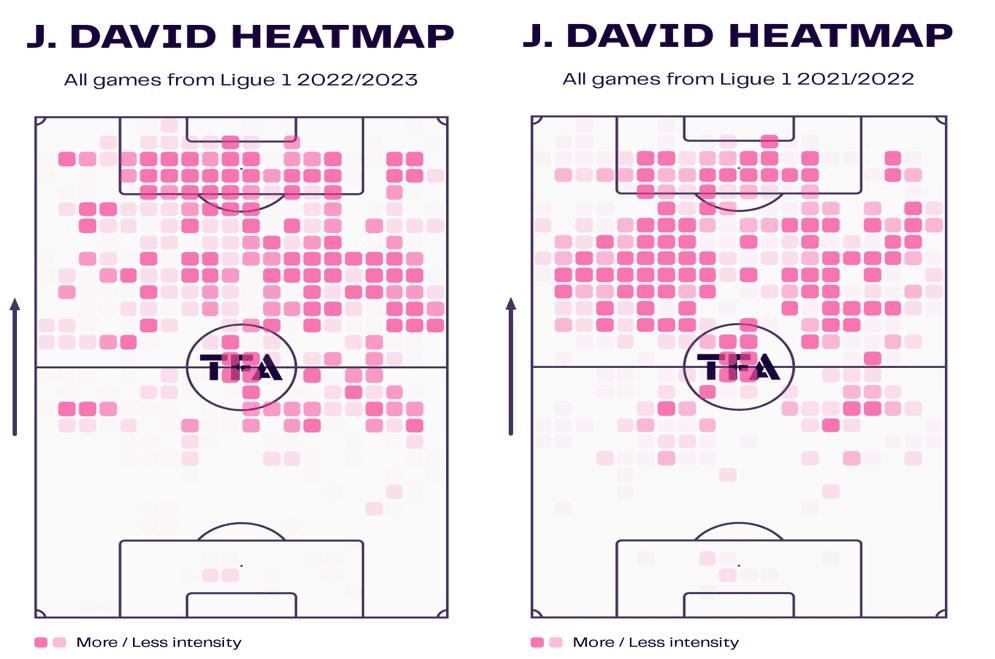
This season, Paulo Fonseca has used him as the lone forward in a 4-2-3-1 formation. Fonseca likes his teams to dominate possession and the former Roma and Shakhtar manager wants his front-forward players to rotate positionally around the attacking third.
Even though this movement and rotation enable David not to be restricted to remaining central and play as the team’s only focal point, there has been a clear emphasis from Fonseca to have David impact the play closer to the opposition’s goal. You can see in the heat map we provided how he is impacting Lille’s play more in the opponent’s penalty area than he was last season.
Goalscoring Threat
This season, Jonathan David is currently on target to achieve his best goal-scoring season. Here is his xG map which displays his shots on goal from aerial and goal-mouth perspectives.
He scored 7 goals from open play with an xG of 6.9, confirming that, based on the quality chances he is getting, he is neither overperforming nor underperforming with his chance conversion. He is scoring the chances he should be scoring, which at this stage of the season is a good sign for both him as an individual and Lille as a team.
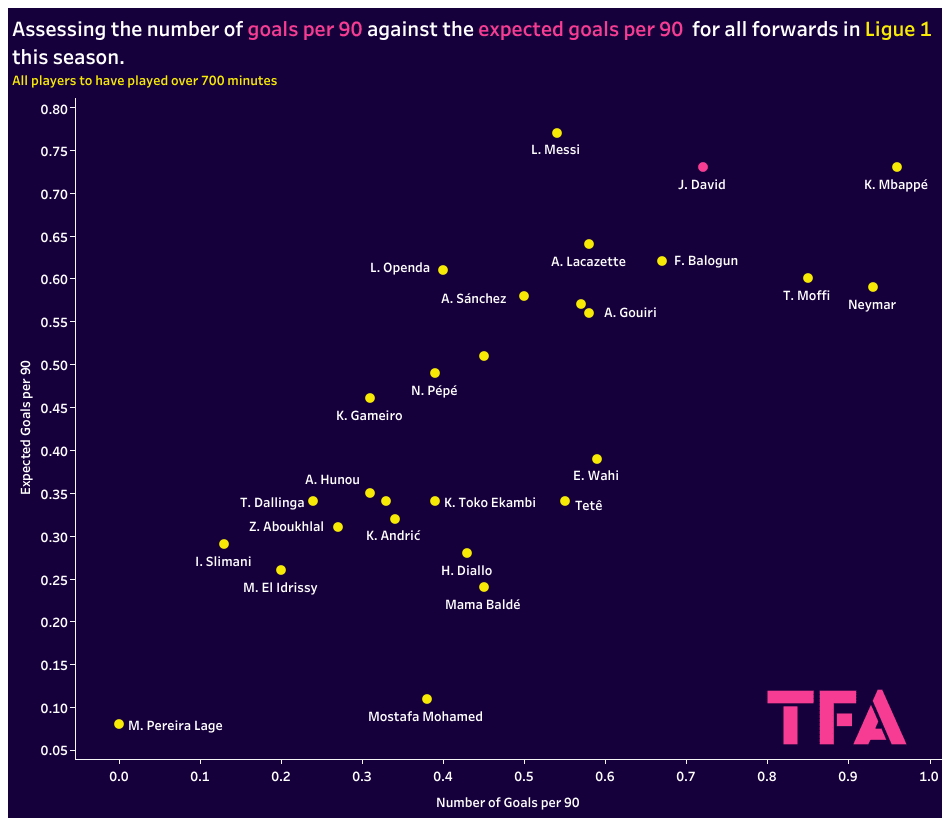
When you compare his goal-scoring numbers against the forwards in Ligue 1 it shows how well he is performing during the first part of the season. The scatter chart below measures the number of goals scored per 90 against the number of expected goals per 90 for all forwards that have played over seven hundred minutes in Ligue 1 this season.
David has the fourth-highest number of goals per 90 with 0.72 and has the second-joint highest xG per 90 with 0.73.
Off-the-ball movement
The Canadian’s ability to anticipate play and attack space has seen him develop into being able to lead the line and play as the centre forward in Lille’s 4-2-3-1 formation.
Having speed to run into space is one thing that Jonathan David has always had but having good off-the-ball movement and being able to exploit the space that the team’s movement creates, has been another development in his game. His development in this area has played an important role in his performance. It contributes effectively to how Lille want to attack.
The next two images show examples of Lille coming up against a mid-block and a low block and it shows how David’s movement is the decisive part of Lille finishing their attack in both images.
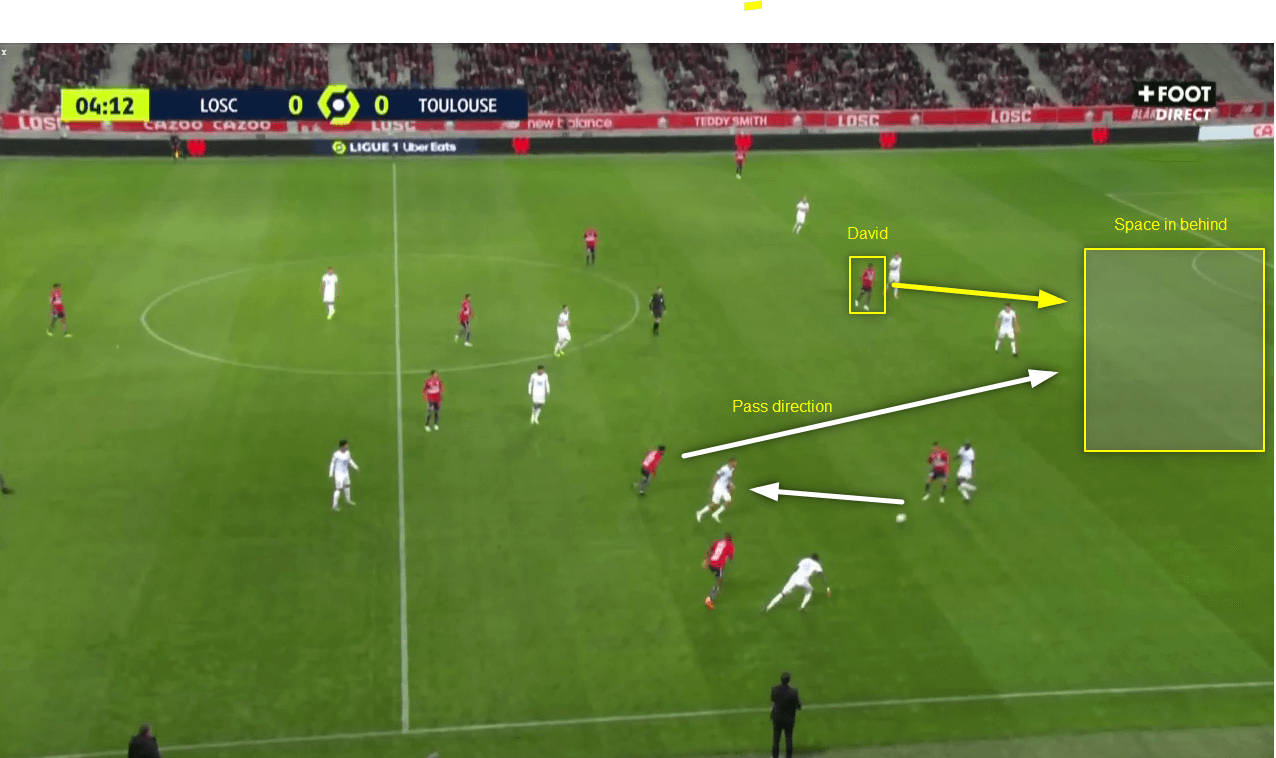
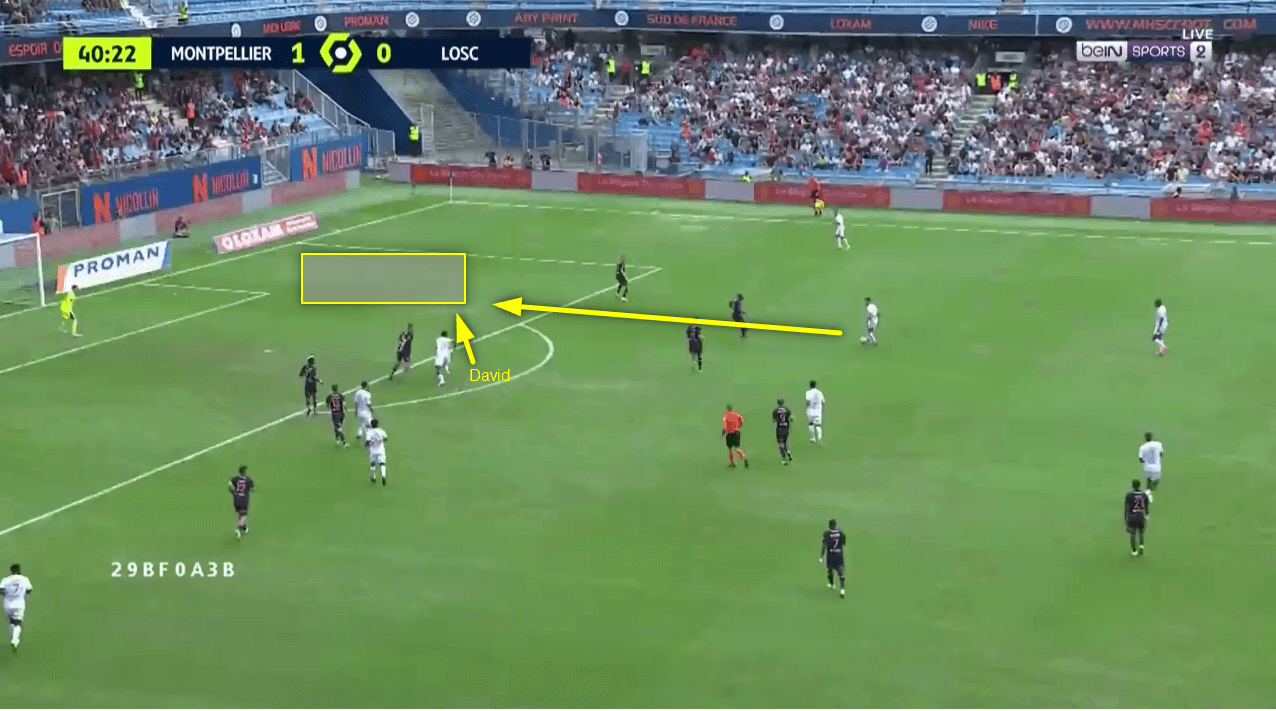
Both examples show David running into the right areas behind the defence, creating the final passing opportunity. Even though the pass still must be delivered with quality, it’s his movement into these areas that make the opportunities.
Fonseca wants Lille to attack and move fluidly in the attacking third and he wants his attack to play narrow with both wingers coming inside. So, Jonathan David playing off the shoulder is crucial at creating space as the centre-backs are likely to follow. If this didn’t happen the team’s attack would become congested.
Link-up play
Attacking space behind the defence is good for creating space in front of the defence as it pulls the opposition’s defence towards their own goal. Another type of movement that Jonathan David is developing within his game is when he decides to move towards the play and act as the link-up.
As he plays as the 1 in the 4-2-3-1 system, it is a requirement that David drops into the space between the lines as well as making runs into the space in behind, as this creates space behind the defence for the other attackers to attack from deeper positions. This is especially important against teams who defend in a low block and who leave limited space behind their defence to attack.
You can see below how Lille are building up in a 2-3-5 attacking shape. This time instead of running in behind David drops into the space between the lines as Bafodé Diakité plays the ball through Monaco’s midfield. By dropping off at this point and linking the play, he immediately opens up space by pulling Monaco’s centre back from his defensive line.
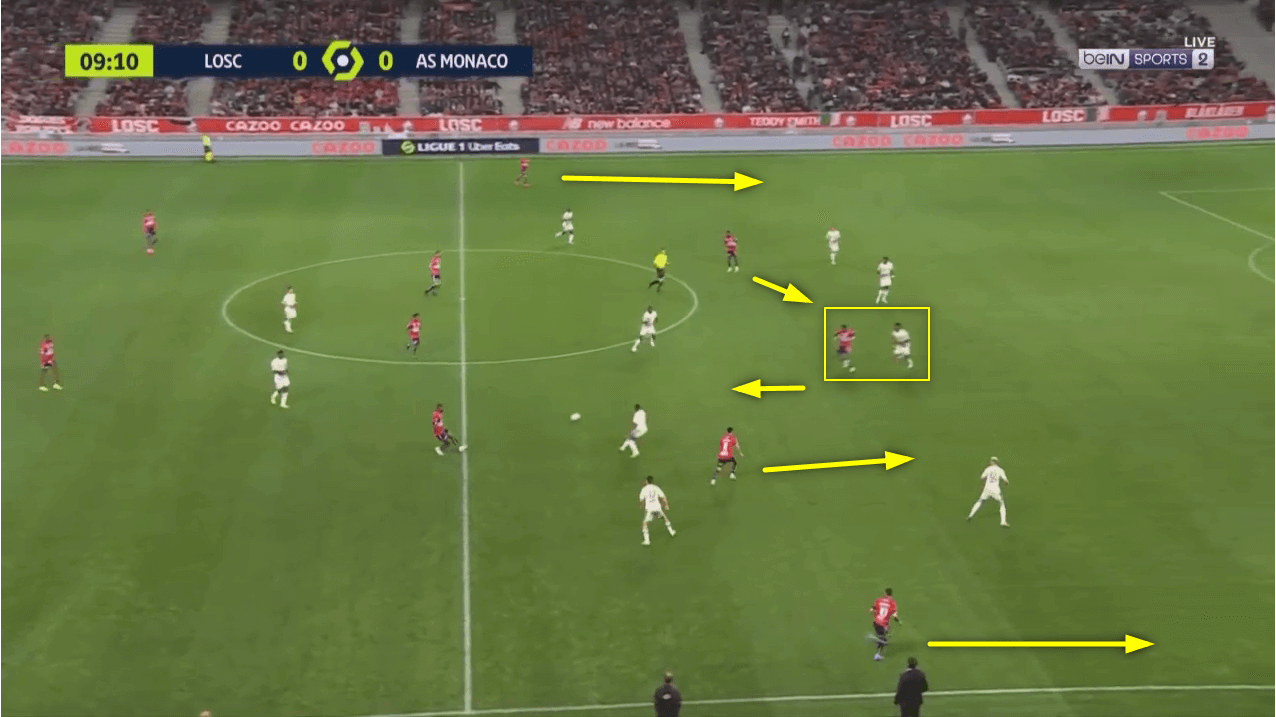
Timing this movement is important as it creates multiple passing opportunities for Lille to be able to progress the ball further into their attacking third. Doing it at the point where the pass can’t be played only helps the opposition defend easier and it closes the space for them. So, the movement from David in these passages of play can prove to be pivotal in Lille being able to unlock the opponent’s defence.
You can see how Montpellier’s defensive block is narrow and compact in the image below. They’re protecting the centre of the pitch and trying to force Lille out wide. Rémy Cabella is holding the ball and his options are limited until David drops from the attacking line to link up the play.

Once he receives the ball, he plays a one-two with Cabella and gets it back. The centre-back following him is now behind the play and the right-back pushes further inside to close that space he has vacated. This has a knock-on effect as it creates further space on the outside for Bamba and Ismaily to attack.

Defending from the front
Playing up front as the leading attacker means that Jonathan David plays an important role in Lille’s first line of defence. Paulo Fonseca wants Lille to react strongly when they lose possession by immediately looking to regain it to stop the opposition from trying to counterattack. This is why he likes his attackers to play closer together during the attacking phase because when possession is lost it is easier to counter-press.
The map below shows the impact that David has contributed this season when Lille defend high up the pitch.
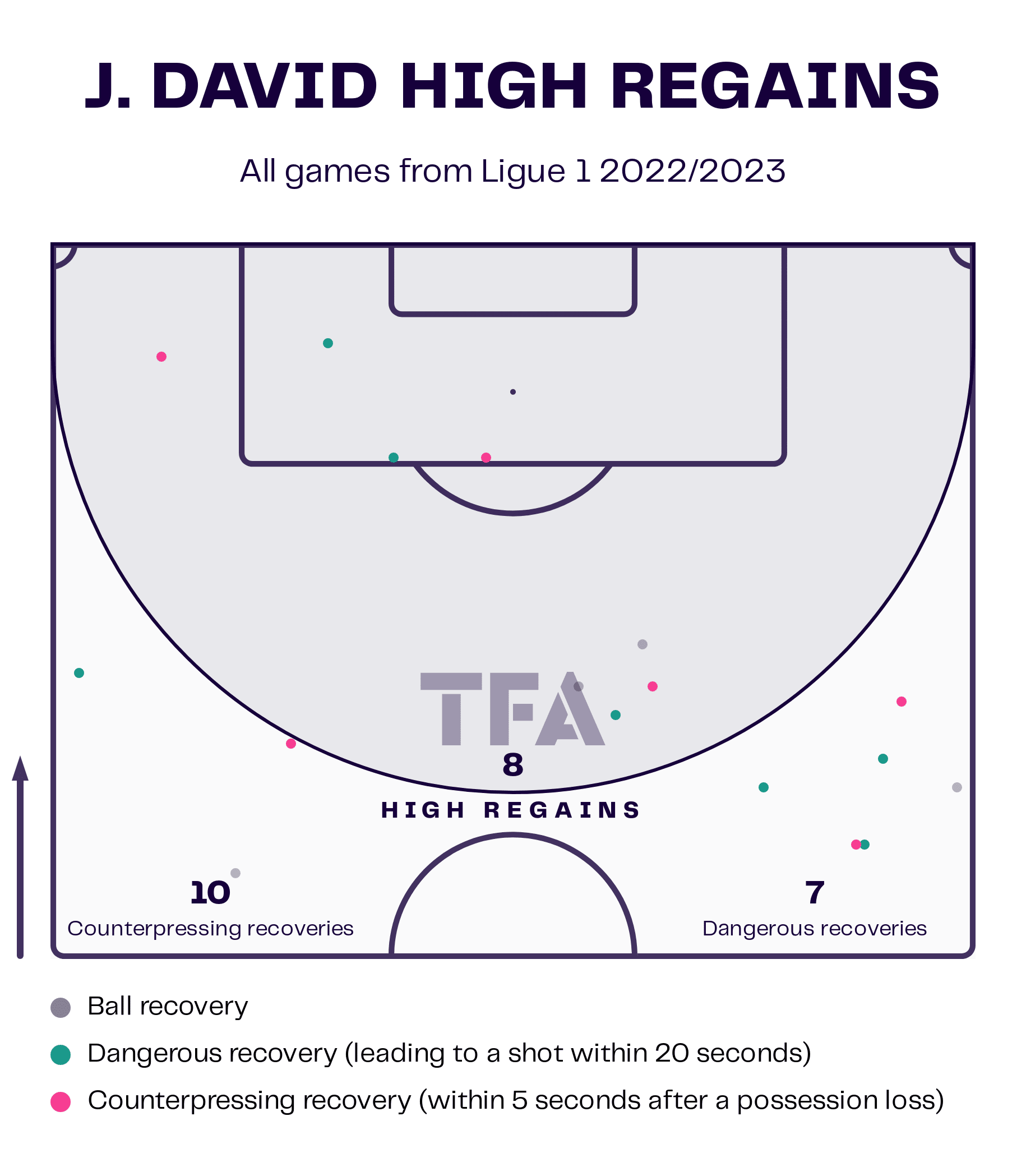
With ten counterpressing recoveries that have led to a shot within five seconds of winning the ball and seven dangerous recoveries that have led to a shot within twenty seconds of winning the ball, the graph shows that the former Gent player plays a useful role within the team’s pressing strategy.
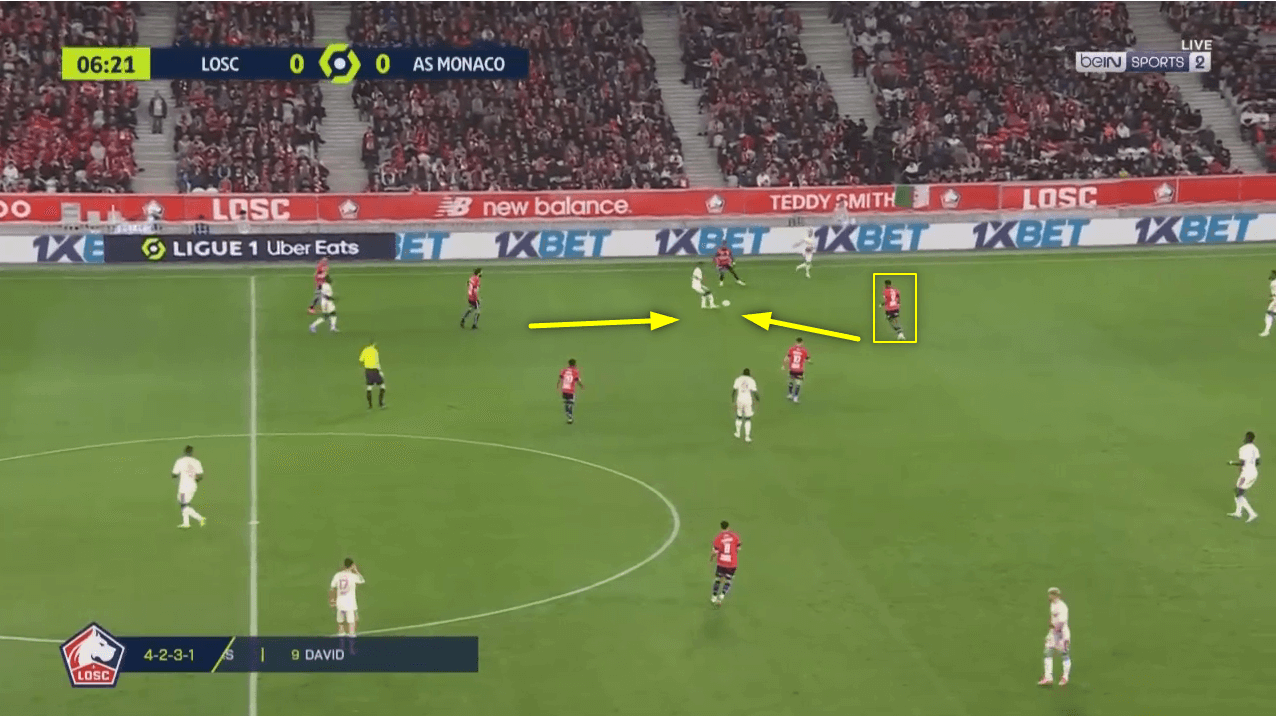
If possession isn’t regained within the counter-press, then Lille tend to drop and defend with a mid-block. They defend in a narrow and compact 4-2-3-1 shape with the relevant full-back pushing on the ball side and the players on the far side coming over to maintain the shape and condense the space.
When the other team are building up, they allow them to have the ball in the defensive third and only assert an aggressive press once the ball is played in the midfield.
If the play is played centrally in front of Lille’s midfield, then it’s Jonathan David who drops back to press the ball carrier. That way Lille keep a solid defensive structure in place as they are not being pulled towards the ball, they are closing the space from behind. Which works with his because of David’s work rate.
This season he is averaging 3.36 defensive duels per 90 with a success rate of 64.29%. His percentile ranking measures at 74.1% for successful defensive duels which confirms he is performing well above average for this specific defensive output.
The map shows the average area of his defensive actions, the average area of his defensive engagement and the eight of the defensive line he defends from.
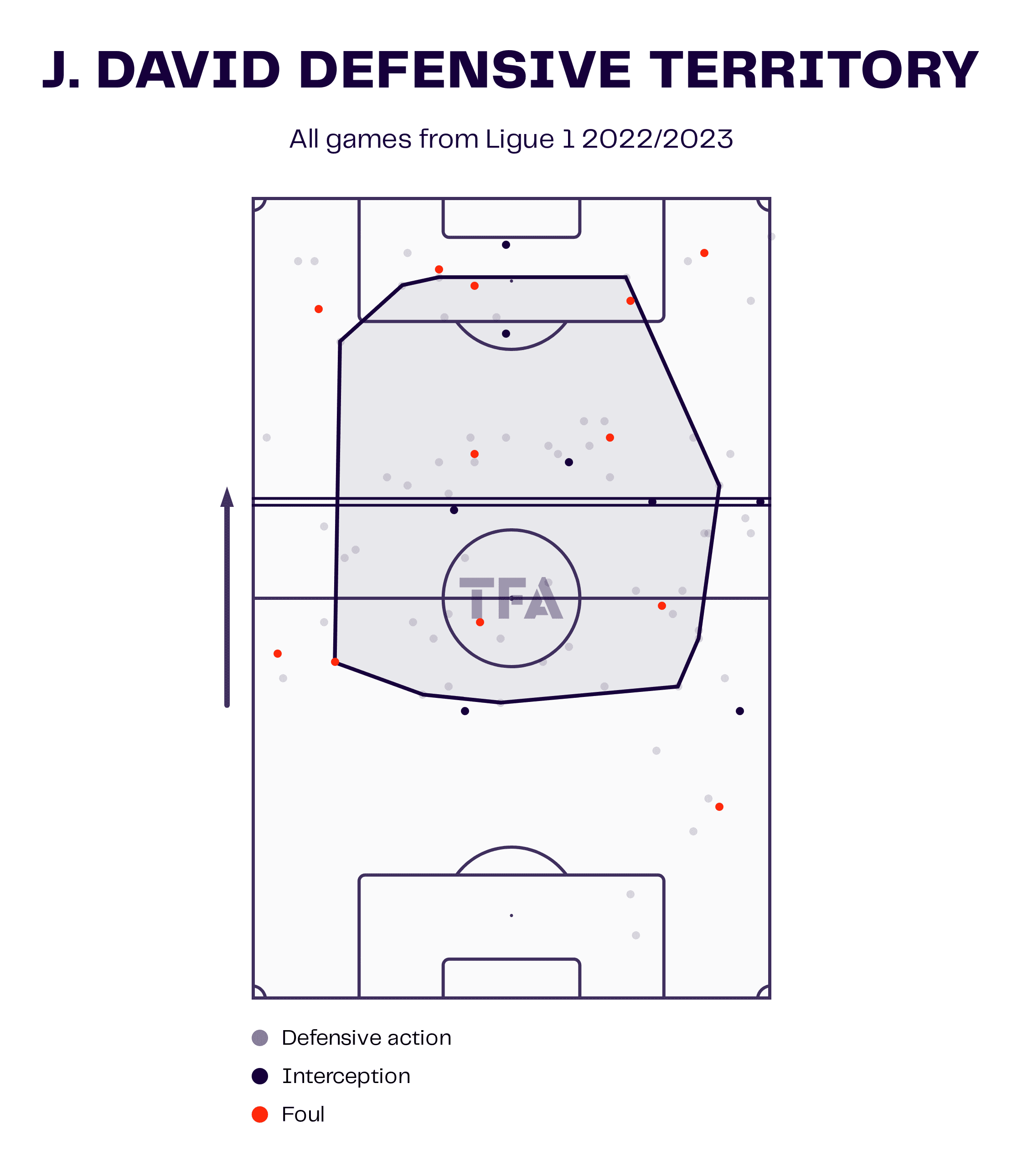
Conclusion
Subject to injuries, Jonathan David is likely to reach his best goalscoring season since joining Lille. He scored thirteen and fifteen goals in the two previous seasons and only made two assists. This left him achieving 0.57 and 0.48 goals and assists per 90. This season he has contributed more assists already than in his two seasons and with him already scoring nine goals he is hitting 1.02 goals and assists per 90.
Although the ratio is unlikely to be maintained throughout the season, the fact that David contributes to his team’s play will make him more appealing to other teams.
Last season, he has shown he can function in a 4-4-2 and play effectively as part of a two-man forward line. This season he is proving he can adapt and contribute to other aspects of his team’s approach by playing as a lone striker in 4-2-3-1.
This scout report identified the key components within Jonathan David’s game. We have shown the strong points within his attacking play and how they contribute to his performance overall. Given the impetus that pressing has in the modern day, we have shown how David contributes to the team’s defensive style too.






Comments